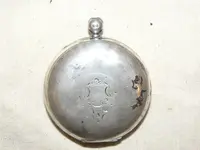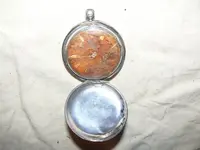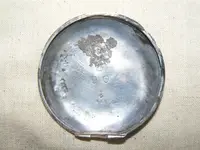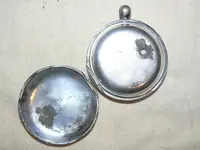tuatara
Hero Member
It happened after we sold our gold-seeking machine and before we bought a relic-hunting beeper. We were just travelling like normal people. Once during holidays we drove to a remote area. While exploring it, we kept our eyes glued to the ground not because we expected to find some treasure in that desolate place. It is a snakey country and you cannot easily ignore them, deadly critters (big too, around the 2.5 meter mark). We saw already a huge one disappearing under a turf of grass. To the left of the path, there was an almost dried up pond. And there, on a mud crust, my friend, Safe-T-Man, noticed a pitch-black round object. Off he rushed to have a look. And soon came back with a grin holding a water-worn fob watch. We thought it was some cheap ‘penny’ watch and I put it into our backpack without a second glance. At home, however, we gave our find a more careful examination and immediately saw British hallmarks – Birmingham, 1898, case maker ‘J.R’. Solid silver. Every hallmarked thing is a milestone for us. One don’t have to guess long about their date and origin and often maker. And there was something interesting about the watch - several dates were neatly scratched on the inner side of its lid, the last one being 1914. I guess those were dates when the watch got into repairs. On the front scratched were 3 letters, most likely the owner’s initials. I am always wondering how things got to where we find them. Are they simply lost, thrown away or is it some accident? This watch really struck my curiosity. A map of the area provided a clue. A country road about 50 km from the place was named after a Scottish pioneering family, and their family name started with the same letter as in the initials on the watch. An inquiry into genealogy of this family was very encouraging. They really owned a big farm in the area and a head of the family who migrated to Australia when he was a very young lad, had a Christian name that matched the first letter of the initials. The only problem was with the middle name. And then I read that in 1900 his son came from Melbourne to help his parents in managing a new farm they bought. And his initials were a complete match. It was ‘my man’. In 1914 he was 35. No accidents. He lived till venerable age of 84. Nevertheless, a tragedy happened. While their land was expanding, the family was dying out. ‘My man’ was an only survivor out of a brood of 7 kids. His siblings did not even reach adulthood. He was married but his marriage was childless. His 2 uncles died young and single. Later when we bought our beeper, we came back and found nearby a plate with their family name and the name of his father’s estate.
Attachments
Upvote
0






